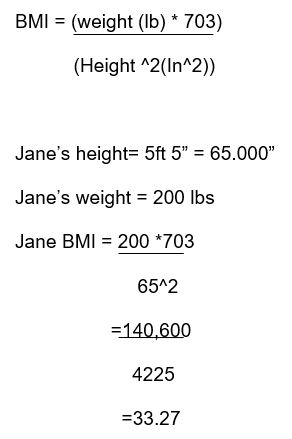
Jane’s body mass index is 33.27 and it falls in the category of Obese Class I. This places Jane’s health at a high risk of getting other diseases associated with obesity. It is recommended that Jane should lose her body weight by at least 33 percent to enable her to attain a normal body mass index. Reduced body weight minimizes the chances of getting diseases such as high blood pressure, diabetes, and heart-related diseases.
For pre-diabetic people, the fasting blood glucose ranges from 100mg/dl to 125mg/dl while that for normal persons without diabetes ranges from 70mg/dl to 90mg/dl (Danaei et al. 32). Jane has various factors that expose her to a higher risk of getting chronic diseases starting from the genetic composition where her father died from a heart attack, and this increases the chances that she may have genetically inherited the problem from her father. Jane is also obese, and this is the major factor causing chronic diseases. Considering that Jane doesn’t engage in doing various physical activities on a daily basis, this puts her at risk of getting chronic diseases (Danaei 365). Her total blood cholesterol is at 250 mg per dl which is at the highest-risk class, and this puts her at the risk of getting illness such as cardiovascular as compared to someone with normal total blood cholesterol.
Jane’s blood pressure is at 130/82mm/Hg which is considered to be higher than that of the normal person whose blood pressure is supposed to have 120/80mm/Hg and below (Danaei et al. 34). This also places her at a higher risk of getting chronic diseases. For a woman, the waist circumference should be 35 inches and below while that of Jane is 38 inches, and this causes overweight which will intern cause some chronic diseases such as diabetes. Metabolic syndrome refers to health factors that cause cardiovascular diseases and other health problems such as diabetes. Notably, Jane has metabolic syndromes including abdominal obesity or a large waistline causing excess fats in her stomach area and it is considered to be a major cause of many heart diseases. Jane also has high blood pressure and it indicates a metabolic syndrome symptom.
Jane’s high-density lipoprotein cholesterol is at 35mg and for women; high-density lipoprotein should be above 50mg and this places her at high risk of getting cardiovascular problems. The low-density cholesterol for Jane is 162mg, this falls under the elevated category causing a reduction of blood circulation in the heart and may result in heart stroke and cardiovascular diseases (Ferket et al. 28). The current total cholesterol for Jane is very high and therefore, it is recommended that she should engage in activities to ensure that it drops below 200 mg per dl which is the ideal level for a healthy person. This will ensure that she is not at risk of having cardiovascular problems. It is also necessary for her to ensure that her low-density lipoproteins drop below 100jmg/dl from the current 162mg/dl to ensure that her health is stable (Kuklina and Keenan 2015).
Jane should also change her diet to enable her to manage her blood pressure health condition. She can achieve this by reducing the amount of sodium she consumes that results from the salt in processed and packaged foods. By doing this, she will be in a good position to lower her blood pressure (Pimenta et al. 478)
Jane should take more fruits and vegetables on a daily basis to reduce high blood pressure. Apart from daily exercise to reduce her weight, Jane should consider reducing the number of calories she consumes through meals (Villareal et al. 2020). Jane can also lose weight by drinking a lot of fluids to ensure that she’s well hydrated thus minimizing taking food when she feels hungry. She should curb stress by all means as this will play a greater role in reducing blood pressure.
Regarding physical activity, Jane should begin with a moderate level of physical activity for at least thirty minutes, three days a week (American College of Sports Medicine 5). She should consistently increase physical activity for an hour of vigorous physical activity each day. This will facilitate weight loss therapy and maintenance.
References
American College of Sports Medicine. ACSM’s guidelines for exercise testing and prescription. Washington D.C: Lippincott Williams & Wilkins, 2013. Print.
Danaei, Goodarz, et al. “National, regional, and global trends in fasting plasma glucose and diabetes prevalence since 1980: systematic analysis of health examination surveys and epidemiological studies with 370 country-years and 2· 7 million participants.” The Lancet. 378.9785 (2011): 31-40. Web.
Danaei, Goodarz, et al. “The preventable causes of death in the United States: comparative risk assessment of dietary, lifestyle, and metabolic risk factors.” PLoS medicine. 6.4 (2009): 365. Web.
Ferket, Bart S., et al. “Systematic review of guidelines on cardiovascular risk assessment: Which recommendations should clinicians follow for a cardiovascular health check?.” Archives of Internal Medicine. 170.1 (2010): 27- 40. Web.
Kuklina, Elena V., Paula W. Yoon, and Nora L. Keenan. “Trends in high levels of low- density lipoprotein cholesterol in the United States, 1999-2006.” Jama. 302.19 (2009): 2104-2110. Web.
Pimenta, Eduardo, et al. “Effects of dietary sodium reduction on blood pressure in subjects with resistant hypertension results from a randomized trial.” Hypertension. 54.3 (2009): 475-481. Web.
Villareal, Dennis T., et al. “Weight loss, exercise, or both and physical function in obese older adults.” New England Journal of Medicine. 364.13 (2011): 1218-1229. Web.